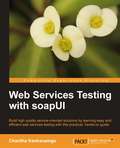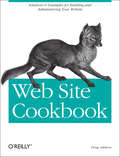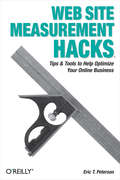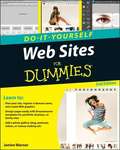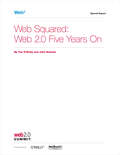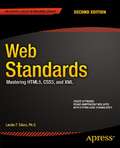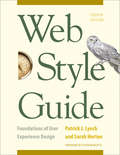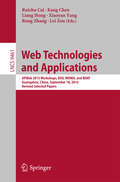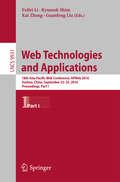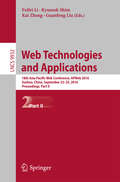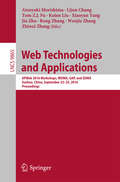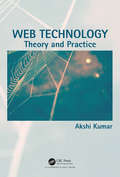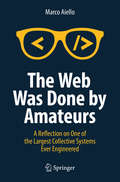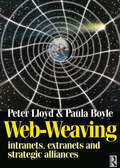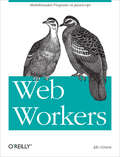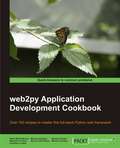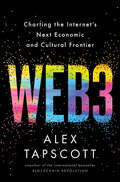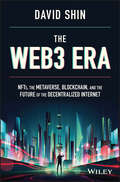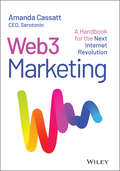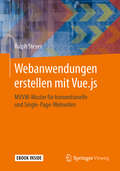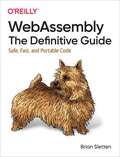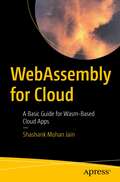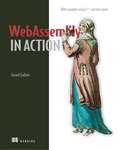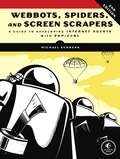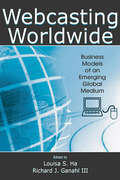- Table View
- List View
Web Services Testing with soapUI
by Charitha KankanamgeWeb Services Testing with soapUI starts with an overview of SOA and web services testing, and gets your hands dirty with a sample project which makes use of open source web service engine, Apache Axis2. All demonstrations and hands-on exercises are based on this sample project. This book is a practical and comprehensive tutorial for easy and efficient web services testing to build high quality service-oriented solutions. This book directly targets software quality assurance professionals, software project managers, and software developers interested in automated or manual testing web services and SOA. Whether you are a seasoned SOA professional or a novice user, with this book you'll learn to effectively use soapUI in testing service-oriented solutions for functional as well as non-functional web services.
Web Site Cookbook
by Doug AddisonThe total number of web pages today has been estimated at over 3 billion, spanning millions of individual websites. Not surprisingly, there is tremendous pressure on web developers and designers to remain current with the latest technologies. The Web Site Cookbook from O'Reilly covers all the essential skills that you need to create engaging, visitor-friendly websites. It helps you with the practical issues surrounding their inception, design, and maintenance. With recipes that teach both routine and advanced setup tasks, the book includes clear and professional instruction on a host of topics, including: registering domains ensuring that hostnames work managing the directory maintaining and troubleshooting a website site promotion visitor tracking implementing e-commerce systems linking with sales sites This handy guide also tackles the various elements of page design. It explains how to control a reader's eye flow, how to choose a template system, how to set up a color scheme, and more. Typical of O'Reilly's "Cookbook" series, the Web Site Cookbook is written in a straightforward format, featuring recipes that contain problem statements and solutions. A detailed explanation then follows each recipe to show you how and why the solution works. This question-solution-discussion format is a proven teaching method, as any fan of the "Cookbook" series can attest to. Regardless of your strong suit or your role in the creation and life of a website, you can benefit from the teachings found in the Web Site Cookbook. It's a must-have tool for advancing your skills and making better sites.
Web Site Measurement Hacks
by Eric T. PetersonIn order to establish and then maintain a successful presence on the Web, designing a creative site is only half the battle. What good is an intricate Web infrastructure if you're unable to measure its effectiveness? That's why every business is desperate for feedback on their site's visitors: Who are they? Why do they visit? What information or service is most valuable to them? Unfortunately, most common Web analytics software applications are long on functionality and short on documentation. Without clear guidance on how these applications should be integrated into the greater Web strategy, these often expensive investments go underused and underappreciated. Enter Web Site Measurement Hacks, a guidebook that helps you understand your Web site visitors and how they contribute to your business's success. It helps organizations and individual operators alike make the most of their Web investment by providing tools, techniques, and strategies for measuring--and then improving--their site's usability, performance, and design. Among the many topics covered, you'll learn: definitions of commonly used terms, such as "key performance indicators" (KPIs) how to drive potential customers to action how to gather crucial marketing and customer data which features are useful and which are superfluous advanced techniques that senior Web site analysts use on a daily basis By examining how real-world companies use analytics to their success, Web Site Measurement Hacks demonstrates how you, too, can accurately measure your Web site's overall effectiveness. Just as importantly, it bridges the gulf between the technical teams charged with maintaining your Web's infrastructure and the business teams charged with making management decisions. It's the technology companion that every site administrator needs.
Web Sites Do-It-Yourself For Dummies
by Janine WarnerA step-by-step guide to creating your first Web siteEverybody's building cool web sites, but how? Web Sites Do-It-Yourself For Dummies, 2nd Edition, shows you how, with simple, step-by-step instruction that will build your confidence as you build your site.You'll learn to plan your site and secure a domain name, how to use Dreamweaver for site construction, and how to test and publish your site. You'll also learn about designing a blog, creating a podcast, adding Flash, and even how to make money with your Web site. Dummies makes it easy and fun!Perfect for those who've never attempted a Web site before, including small-business owners, the family historian, amateur genealogists, and travel buffsExplains using Web site creation tools including Dreamweaver, Photoshop Elements, Flash, and WordPressShows how Web pages work, how to plan and design your site, and what to look for in Web hosting servicesCovers editing and creating Web graphics and text, how to customize a site for different purposes, testing, and publishing your siteProvides information on blogs, podcasts, adding Flash, and making money from your siteWeb Sites Do-It-Yourself For Dummies, 2nd Edition shows you how to create a Web site you'll be proud of.
Web Squared: Web 2.0 Five Years On
by John Battelle Tim O'ReillyEver since we first introduced the term Web 2.0, people have been asking, What's next? Assuming that Web 2.0 was meant to be a kind of software version number (rather than a statement about the second coming of the Web after the dotcom bust), we're constantly asked about Web 3.0. Is it the semantic web? The sentient web? Is it the social web? The mobile web? Is it some form of virtual reality? It is all of those, and more. The Web is no longer a collection of static pages of HTML that describe something in the world. Increasingly, the Web is the world "everything and everyone in the world casts an information shadow, an aura of data which, when captured and processed intelligently, offers extraordinary opportunity and mindbending implications. Web Squared is our way of exploring this phenomenon and giving it a name.
Web Standards
by Leslie F. SikosWeb Standards: Mastering HTML5, CSS3, and XML provides solutions to the most common web design problems, and gives you a deep understanding of web standards and how they can be implemented to improve your web sites. You will learn how to develop fully standards-compliant, mobile-friendly, and search engine-optimized web sites that are robust, fast, and easy to update while providing excellent user experience and interoperability. The book covers all major web standards for markup, style sheets, web typography, web syndication, semantic annotations, and accessibility. This edition has been fully updated with the latest in web standards, including the finalized HTML5 vocabulary and the full list of CSS3 properties. Web Standards: Mastering HTML5, CSS3, and XML is also a comprehensive guide to current and future standards for the World Wide Web, demonstrating the implementation of new technologies to address the constantly growing user expectations. Web Standards: Mastering HTML5, CSS3, and XML presents step-by-step guides based on solid design principles and best practices, and shows the most common web development tools and web design frameworks. You will master HTML5 and its XML serialization, XHTML5, the new structuring and multimedia elements, the most important HTML5 APIs, and understand the standardization process of HTML 5. 1, HTML 5. 2, and future HTML5 versions.
Web Style Guide: Foundations of User Experience Design
by Ethan Marcotte Sarah Horton Patrick LynchA classic reference book on user interface design and graphic design for web sites, updated to reflect a rapidly changing market Consistently praised as the best volume on classic elements of web site design, Web Style Guide has sold many thousands of copies and has been published around the world. This new revised edition confirms Web Style Guide as the go-to authority in a rapidly changing market. As web designers move from building sites from scratch to using content management and aggregation tools, the book's focus shifts away from code samples and toward best practices, especially those involving mobile experience, social media, and accessibility. An ideal reference for web site designers in corporations, government, nonprofit organizations, and academic institutions, the book explains established design principles and covers all aspects of web design--from planning to production to maintenance. The guide also shows how these principles apply in web design projects whose primary concerns are information design, interface design, and efficient search and navigation.
Web Technologies and Applications
by Ruichu Cai Kang Chen Liang Hong Xiaoyan Yang Rong Zhang Lei ZouThis bookconstitutes the refereed proceedings of the workshops held at the 17thAsia-Pacific Web Conference, APWeb 2015, in Guangzhou, China, in September2015. The 15 fullpapers were carefully reviewed and selected from various submissions. The volumepresents the papers that have been accepted for the following workshops: BigData Applications in Telecoms, BDAT 2015, Big Social Data, BSD 2015, and WebData Mining and Applications, WDMA 2015. The papers cover various issues in thearea of the World Wide Web with the underlying technologies and applications.
Web Technologies and Applications
by Feifei Li Kyuseok Shim Kai Zheng Guanfeng LiuThis book constitutes the refereed proceedings of the 16th Asia-Pacific Conference APWeb 2014 held in Changsha, China, in September 2014. The 34 full papers and 23 short papers presented were carefully reviewed and selected from 134 submissions. The papers address research, development and advanced applications of large-scale data management, web and search technologies, and information processing.
Web Technologies and Applications
by Feifei Li Kyuseok Shim Kai Zheng Guanfeng LiuThis book constitutes the refereed proceedings of the 16th Asia-Pacific Conference APWeb 2014 held in Changsha, China, in September 2014. The 34 full papers and 23 short papers presented were carefully reviewed and selected from 134 submissions. The papers address research, development and advanced applications of large-scale data management, web and search technologies, and information processing.
Web Technologies and Applications
by Atsuyuki Morishima Rong Zhang Wenjie Zhang Lijun Chang Tom Z. J Fu Kuien Liu Xiaoyan Yang Jia Zhu Zhiwei ZhangThis book constitutes the refereed proceedings of three workshops held at the 18th Asia-Pacific Web Conference, APWeb 2016, in Suzhou, China, in September 2016: the Second International Workshop on Web Data Mining and Applications, WDMA 2016, the First International Workshop on Graph Analytics and Query Processing, GAP 2016, and the First International Workshop on Spatial-temporal Data Management and Analytics, SDMA 2016. The 27 full papers included in this book were carefully reviewed and selected from 37 submissions. The goal of these workshops is to promote the new research directions and applications, especially on web data, graph data, and spatial-temporal data management and analytics.
Web Technology: Theory and Practice
by Akshi KumarThis book intends to expound the complete concept of Web in Theory, Web in Research and Web in Practice with the help of worked out examples for better understanding. Planned as a comprehensive reading for beginners and a reference for advanced learners, the book includes latest developments and approaches related to the World Wide Web.
The Web Was Done by Amateurs: A Reflection on One of the Largest Collective Systems Ever Engineered
by Marco AielloThis book stems from the desire to systematize and put down on paper essential historical facts about the Web, a system that has undoubtedly changed our lives in just a few decades. But how did it manage to become such a central pillar of modern society, such an indispensable component of our economic and social interactions? How did it evolve from its roots to today? Which competitors, if any, did it have to beat out? Who are the heroes behind its success?These are the sort of questions that the book addresses. Divided into four parts, it follows and critically reflects on the Web’s historical path. “Part I: The Origins” covers the prehistory of the Web. It examines the technology that predated the Web and fostered its birth. In turn, “Part II: The Web” describes the original Web proposal as defined in 1989 by Tim Berners-Lee and the most relevant technologies associated with it. “Part III: The Patches” combines a historical reconstruction of the Web’s evolution with a more critical analysis of its original definition and the necessary changes made to the initial design. In closing, “Part IV: System Engineering” approaches the Web as an engineered infrastructure and reflects on its technical and societal success.The book is unique in its approach, combining historical facts with the technological evolution of the Web. It was written with a technologically engaged and knowledge-thirsty readership in mind, ranging from curious daily Web users to undergraduate computer science and engineering students.
Web-Weaving
by Peter Lloyd Paula BoyleIntranets and Extranets are the fastest growing use of internet technology and are being adopted by a large number of organizations. `Web-Weaving' is a book for managers which illustrates the benefits and pitfalls of using technology to enhance internal and external connections. The book brings together a number of the hottest subjects in IT and Organizational Development using contributions from innovative thinkers and practitioners in both areas. The first section defines what web-weaving actual is, describing the huge range of communication technology available to organizations at the moment. The second section reviews web-weaving in practice using case studies of companies using intranet and extranet technology. The third section brings together commentaries from leading players in both the IT and Human Resources fields to predict the future of web-weaving and the huge impact it will have on the way organizations and the people within them will work together in the future.
Web Workers
by Ido GreenWeb apps would run much better if heavy calculations could be performed in the background, rather than compete with the user interface. With this book, you'll learn how to use Web Workers to run computationally intensive JavaScript code in a thread parallel to the UI. Yes, multi-threaded programing is complicated, but Web Workers provide a simple API that helps you be productive without the complex algorithms. If you have an intermediate to advanced understanding of JavaScript-- especially event handling and callbacks--you're ready to tackle Web Workers with the tools in this example-driven guide. Start creating Web Workers and understand what they can and can't do Determine which browser versions support the API Use dedicated Web Workers for tasks that consume a lot of CPU, such as data parsing Explore use cases for creating inline Workers, such as encapsulating a web app in one page Create a shared Worker to communicate multiple web app instances to the server, and other uses Learn best practices for debugging Web Workers Apply Web Workers within the server-side Node environment
web2py Application Development Cookbook
by Mariano Reingart Pablo Martin MuloneThis is a cookbook and you may read the chapters in any order. The recipes need not be read sequentially. There are a good amount of code examples and relevant screenshots to ease learning pains. The target audience are Python developers with basic knowledge of web2py who want to gain further knowledge of web2py
Web3: Charting the Internet's Next Economic and Cultural Frontier
by Alex TapscottA WALL STREET JOURNAL AND GLOBE AND MAIL BESTSELLER An essential introduction and guide to navigating the next Internet revolution—everything from the metaverse and NFTs to DAOs, decentralized finance, and self-sovereign identity—from the co-author of the international bestseller Blockchain Revolution.The Web, and with it the Internet, are entering a new age. We’ve moved from the “Read-only Web,” which had little functionality for interacting with content, to the “Read-Write Web,” which offered seemingly endless collaborative opportunities, from sharing with our favorite people to shopping at our favorite brands. But the profusion of cyberattacks, data hacks, and online profiling have left many of us to view digital life as a Faustian bargain in need of a major rethink.That rethink is Web3, the “Read-Write-Own Web”—a decentralized Internet where individuals own their own identities and can securely trade assets like money, securities, intellectual property, and art peer to peer. Made possible by blockchains, the foundational technology of bitcoin, Web3 promises the biggest shake up of business since the invention of double-entry bookkeeping in the Middle Ages. It is the Internet’s new frontier.In Web3, award-winning author and technology investor Alex Tapscott provides a cutting-edge guide to the Internet’s next era. Covering everything from the metaverse and non-fungible tokens to DAOs, decentralized finance, and self-sovereign identity, this indispensable, forward-thinking book describes the building blocks and often hidden technologies that will be foundational to our cultural and economic progress.
The Web3 Era: NFTs, the Metaverse, Blockchain, and the Future of the Decentralized Internet
by David ShinGet a sneak peek into the future of technology, finance, and the metaverse In The Web3 Era: NFTs, the Metaverse, Blockchain and the Future of the Decentralized Internet, renowned finance and technology expert David Shin connects pivotal moments from the history of human progress and global trade with current events that are shaping the world of tomorrow through a fascinating and insightful exploration of the long-term, next-level use cases of non-fungible tokens and digital assets, and their implications for industries that leverage these advancements. In the book, you’ll find discussions of the challenges and opportunities for institutions awaiting the arrival of the Web3 space; how old Western central powers are struggling to keep up with the digital currencies of the East; and why our voices will matter as consensus-driven tribes converge to form DAOs. You’ll also discover the potential of blockchain as a pivotal engine for driving the metaverse economy and transforming contemporary web infrastructure into a decentralized network of free trade and social interaction governed by users themselves. The author covers topics that include: The potential institution of a smart treasury in a digital economy The convergence of metaverse infrastructure with decentralized finance, creating a virtual world of open finance Use cases for government-backed digital tokens in a variety of industries, including education, healthcare, and banking Social interactions and commerce tied to Soulbound-identity, A.I. technology, archeological revelations, de-dollarization, and the rising Global SouthAn essential and one-of-a-kind resource for business leaders, executives, entrepreneurs, investors, and finance professionals, The Web3 Era: NFTs, the Metaverse, Blockchain and the Future of the Decentralized Internet will also benefit technology enthusiasts, digital marketers, and digital transformation specialists who seek to gain invaluable insights into the future of technology and finance, as well as anyone who believes that we are in need of a new system of governance for a better tomorrow.
Web3 Marketing: A Handbook for the Next Internet Revolution
by Amanda CassattTHE ESSENTIAL WEB3 MARKETING BOOK For a limited time, claim an NFT with a copy of your book! Web3 Marketing: A Handbook for the Next Internet Revolution is the essential book for anyone looking to understand the next era of the internet and start building. Beyond the sensational hype and headlines around crypto and NFTs, a real revolution is taking place: new technologies for owning, moving, and organizing value spell the overdue end of an internet where a few huge companies hoard data and power, and open a new frontier for products, services, and applications in which ownership and control belongs to creators, builders, and users. As former CMO of ConsenSys then Founder and CEO of top web3 marketing firm Serotonin—Amanda Cassatt is in a unique position to tell this story, and delivers a remarkably clear, nontechnical guide to the history, key concepts, and still-evolving landscape of Web3. Cassatt explains how Web3 transforms time-tested approaches to marketing and brand-building, including how to build a Web3 community. This book is a must-read for professionals at any level in their Web3 careers—already working or investing in Web3, exploring what it means for their business, or considering a jump into something new—and for anyone who wants to understand the next internet revolution.
Webanwendungen erstellen mit Vue.js: MVVM-Muster für konventionelle und Single-Page-Webseiten
by Ralph SteyerSteigen Sie mit diesem Buch schnell und unkompliziert in Vue.js einDieses Buch bietet einen kompakten und praxisnahen Einstieg in das populäre Vue.js. Nutzen Sie auf Basis von MVC-Entwurfsmustern das MVVC-Konzept für Anwendungen im Web und erstellen Sie damit auf einfache Weise Single-Page-Webanwendungen. Dabei verwenden Sie eines der leistungsfähigen Frameworks nur auf Basis elementarer WWW-Standardtechnologien. Mit Vue.js werden Sie Datenbindung, Komponenten, Direktiven und Modularität verstehen und anwenden. Mit diesem Buch lernen Sie nicht nur die wichtigsten Grundlagen von Vue.js kennen. Erfahren Sie außerdem, wie Sie mit diesem JavaScript-Webframework Webapplikationen erstellen und pflegen. Der Fokus des umfassenden Werks liegt auf folgenden Aspekten:· HTML/CSS/JavaScript und das Web: Das Umfeld von Vue.js· Basis von JavaScript (darunter vor allen Dingen JSON)· Arbeiten mit der Vue-Instanz· Templates· Double Curly Syntax und Datenbindung Durch seinen starken Anwendungsbezug eignet sich dieses Buch über Vue.js als idealer Begleiter für das Selbststudium oder entsprechende Kurse. Inhaltlich richtet es sich an:a) Ersteller von Webseitenb) Programmiererc) Web-Designer Tauchen Sie noch tiefer in die Materie ein Ralph Steyer zeigt, welche Voraussetzungen Sie zum Arbeiten mit diesem Buch mitbringen sollten. Anschließend erfahren Sie mehr über das Framework sowie die speziellen Features von Vue.js. Im weiteren Verlauf behandelt der Autor u. a. diese Teilaspekte:· Erste Beispiele – Vue.js einfach einmal testen· Wie und warum funktioniert Vue.js?· Bedingtes Rendern: Die v-if-Direktive – Entscheidungen treffen· Dynamische Layouts mit Datenbindung – Stylesheets dynamisieren· Formulare und Formulardatenbindung – Interaktion mit dem Anwender· Übergänge und Animationen – Bewegende Dinge Wer noch mehr über die Applikation erfahren will, dem gibt dieses Buch im abschließenden Kapitel noch einen Ausblick auf weitere Einsatzmöglichkeiten und Funktionen von Vue.js. Um Ihnen den Einstieg zu erleichtern, finden Sie in jedem Kapitel Programmcodes und Abbildungen, die komplexe Vorgänge veranschaulichen.
WebAssembly: Safe, Fast, And Portable Code
by Brian SlettenWebAssembly: The Definitive Guide is a thorough and accessible introduction to one of the most transformative technologies hitting our industry. What started as a way to use languages other than JavaScript in the browser has evolved into a comprehensive path toward portability, performance, increased security, and greater code reuse across an impressive collection of deployment targets.Author Brian Sletten introduces elements of this technology incrementally while building to several concrete, code-driven examples of practical, cutting-edge WebAssembly uses. Whether you work with enterprise software or embedded systems, or in entertainment, scientific computing, or startup environments, you'll learn how WebAssembly can have a positive impact on the way you develop software.Use WebAssembly to increase code portability across platformsReuse more of your software assets in a wider number of deployment targetsLearn how WebAssembly increases protection against prominent security attacksUse WebAssembly to deploy legacy code in web environmentsIncrease your user base across languages and development environmentsIntegrate JavaScript code with other languages and environments to improve performance, security, and productivityLearn how WebAssembly will affect your career as software developer
WebAssembly for Cloud: A Basic Guide for Wasm-Based Cloud Apps
by Shashank Mohan JainJourney into the amazing world of WebAssembly (Wasm) and learn about how it can be applied on the cloud. This book is an introduction to Wasm aimed at professionals accustomed to working with cloud-related technologies such as Kubernetes and Istio service mesh. Author Shashank Jain begins with an introduction to Wasm and its related tooling such as wasm-bindgen and wapc. He then walks you through code examples using Rust, Golang, and JavaScript to demonstrate how they can be compiled to Wasm and consumed from Wasm runtimes deployed standalone, as well as on the cloud. You will see how a wasm module can be run through an http interface, and how Wasm fits into CNCF projects such as Kubernetes and Istio service mesh. After that, you’ll learn how the polyglot nature of WebAssembly can be leveraged through examples written in languages like Rust and consumed via Golang and JavaScript, with a focus on how WebAssembly allows interoperability between them. You’ll gain an understanding of how Wasm-based modules can be deployed inside Linux containers and orchestrated via Kubernetes, and how Wasm can be used within the Istio proxy to apply rules and filters. After reading this book, you’ll have the knowledge necessary to apply WebAssembly to create multi tenanted workloads which can be polyglot in nature and can be deployed on cloud environments like Kubernetes. What You Will Learn Understand how Wasm can be used for server-side applicationsLearn about Wasm memory model and Wasm module layoutHow communication between host and Wasm module is facilitatedThe basics of Wasm sandboxing and securityThe fundamentals of tooling around Wasm, such as WAT and Wasm-packCreate a Wasm module in Rust and consume it from JavaScript, Rust and Golang.Grasp how Kubernetes can be used to orchestrate Wasm-based workloadsHow Wasm fits into service mesh Who Is This Book For Software developers/architects who are looking to hone their skills in virtualization and explore alternatives to Docker and container-based technologies for their workload deployments. Readers should have a basic programming background in languages such as Rust and Golang to get the most out of this book.
WebAssembly in Action: With examples using C++ and Emscripten
by Gerard Gallant"Atwood's Law" is driven by the idea that all applications will ultimately wind up on the web and therefore must be written in JavaScript. WebAssembly may be your way out! With WebAssembly, you can write in nearly any modern language and run your code in the browser through a memory-safe, sandboxed execution environment that can be embedded in a web browser and other platforms. Getting set up and moving with WebAssembly requires you to modify your web dev process; WebAssembly in Action will get you started quickly and guide you through real-world examples and detailed diagrams that help you create, run, and debug WebAssembly modules. Purchase of the print book includes a free eBook in PDF, Kindle, and ePub formats from Manning Publications.
Webbots, Spiders, and Screen Scrapers, 2nd Edition
by Michael SchrenkThere's a wealth of data online, but sorting and gathering it by hand can be tedious and time consuming. Rather than click through page after endless page, why not let bots do the work for you?Webbots, Spiders, and Screen Scrapers will show you how to create simple programs with PHP/CURL to mine, parse, and archive online data to help you make informed decisions. Michael Schrenk, a highly regarded webbot developer, teaches you how to develop fault-tolerant designs, how best to launch and schedule the work of your bots, and how to create Internet agents that:–Send email or SMS notifications to alert you to new information quickly–Search different data sources and combine the results on one page, making the data easier to interpret and analyze–Automate purchases, auction bids, and other online activities to save timeSample projects for automating tasks like price monitoring and news aggregation will show you how to put the concepts you learn into practice.This second edition of Webbots, Spiders, and Screen Scrapers includes tricks for dealing with sites that are resistant to crawling and scraping, writing stealthy webbots that mimic human search behavior, and using regular expressions to harvest specific data. As you discover the possibilities of web scraping, you'll see how webbots can save you precious time and give you much greater control over the data available on the Web.
Webcasting Worldwide: Business Models of an Emerging Global Medium (Media Management and Economics Series)
by Louisa HaWebcasting Worldwide tackles one of the most timely topics in mass communication today—the delivery of audio and video content via the Web, or webcasting—employing a global perspective to explore the subject. It is unique in providing a theoretical framework by which to analyze business models of emerging media, and it also examines the business practices of leading webcasters in the world’s most developed broadband markets. With webcasting in its early development, the approaches discussed in this volume set the standards for the webcasting industry. Representing the major broadband markets in the world, this text is an authoritative and valuable reference for both researchers and practitioners. The chapters relate the business practices of webcasting to the media market environment and established media industries, such as television and radio, as well as government and non-profit organizations. Downloadable resources offer PowerPoint charts for use in training, education, and research, along with tables, graphs, screenshots, and hyperlinks. Webcasting Worldwide is essential reading for academic researchers and media industry practitioners, and the volume will be a useful text in advanced courses addressing media technology, media management, and international communication.For updates about the book chapters and latest commentaries on topics related to webcasting business models, please visit the Webcasting Business Models Blog at http://webcastingworldwide.blogspot.comWinner of The Association for Education in Journalism and Mass Communication Picard Award for Media Management and Economics 2007.
